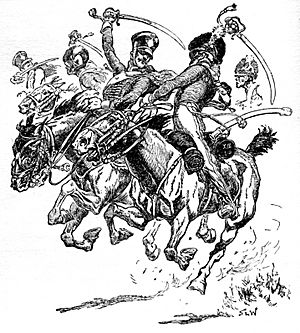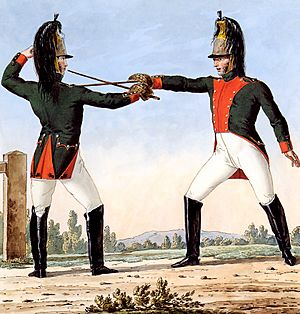Battle of Campo Maior facts for kids
The Battle of Campo Maior was a fight that happened on March 25, 1811. It was part of the Peninsular War, a big conflict in Europe. In this battle, soldiers from Britain and Portugal, led by William Beresford, fought against French forces led by Marie Victor de Fay, marquis de Latour-Maubourg.
The battle took place near a town called Campo Maior in Portugal. It started when some British and Portuguese cavalry (soldiers on horseback) attacked the French. They were very successful at first. However, some of the Allied horsemen chased the French too far. Because of a misunderstanding, their commander, Beresford, stopped his main army. This allowed the French to get away and even get back some cannons they had lost.
Quick facts for kids Battle of Campo Maior |
|||||||
|---|---|---|---|---|---|---|---|
| Part of the Peninsular War | |||||||
 The 13th Light Dragoons pursued the beaten French cavalry at Campo Maior, 25 March 1811, by Stanley L. Wood |
|||||||
|
|||||||
| Belligerents | |||||||
| Commanders and leaders | |||||||
| Strength | |||||||
| 2,400 | 700 | ||||||
| Casualties and losses | |||||||
| 200 killed, wounded or captured 1 gun lost |
168 killed, wounded or captured | ||||||
Contents
What Led to the Battle?
In the winter of 1810–1811, the French army was trying to capture Lisbon, the capital of Portugal. They were fighting against the British and Portuguese army led by Lord Wellington. Wellington's army was safe behind strong defenses called the Lines of Torres Vedras.
The French army, led by Marshal André Masséna, eventually ran out of food and supplies. So, they started to retreat in March 1811. At the same time, another French army, led by Marshal Nicolas Soult, was attacking the city of Badajoz to the south. Badajoz fell to the French on March 11.
After capturing Badajoz, a French general named Édouard Mortier and his troops attacked Campo Maior Castle. This old Portuguese fortress was defended by about 800 local soldiers and 50 old cannons. They fought bravely for several days but had to give up on March 21.
When William Beresford heard that Badajoz had fallen, he was already leading a large army to help. He decided to keep going to try and take Badajoz back from the French.
The Battle Begins
The French were leaving Campo Maior and needed to move their captured cannons to Badajoz. General Latour-Maubourg was in charge of protecting these cannons. His force included about 1,200 infantry soldiers, some horse artillery, and eight groups of cavalry.
To stop the French, Beresford sent Brigadier General Robert Ballard Long ahead with a strong cavalry force. This group had British and Portuguese cavalry units. Only about 700 horsemen and two cannons actually fought in the battle. These included the British 13th Light Dragoons and the Portuguese 1st and 7th Cavalry Regiments.
On March 25, Long ordered the 13th Light Dragoons to charge the French 26th Dragoons. The Portuguese 7th Dragoons helped protect their side. The British cavalry was very effective. They broke through the French dragoons, and their commander was killed. The French cavalry was completely defeated and ran towards Badajoz.
One historian said that the 13th Light Dragoons, who were only about 200 men, did an amazing job defeating a French force two or three times their size.
The Wild Chase and Its Problems
After their victory, the British horsemen, followed by the Portuguese dragoons, started chasing the defeated French soldiers. They found the convoy of 18 French cannons and captured them. They kept chasing the French for about 11 kilometers (7 miles)! Some of the British dragoons even charged right up to the walls of the Badajoz fortress, but they were pushed back by gunfire from the city.
French cavalry then came out of Badajoz to drive the Allied horsemen away. Meanwhile, Beresford, the main Allied commander, had received a wrong report. He was told that the 13th Light Dragoons had all been captured. Because of this, he stopped his main army from advancing, even though his cannons were firing and his infantry was getting close to the French.
Because Beresford stopped his troops, the French infantry was able to continue their march without being bothered. They easily took back their cannons and brought them safely into Badajoz. However, the Allied cavalry did manage to keep one captured cannon, a howitzer, which was lighter and easier to move.
What Happened Next?
The French lost about 200 soldiers, either killed, wounded, or captured, and one cannon. The 26th Dragoons alone lost 108 men. The Allied forces lost 168 soldiers. The 13th Light Dragoons had 10 killed, 27 wounded, and 22 captured. The Portuguese regiments lost 14 killed, 40 wounded, and 55 captured. The Allies did succeed in taking back Campo Maior.
The chase of the French force didn't go as well as it could have, even though the British and Portuguese had more soldiers. There was a lot of disagreement later about why this happened. Some people thought that Brigadier Long had lost control of his cavalry. Others, like the historian Sir William Napier, believed that if Beresford had sent in his heavy cavalry, they could have forced the French infantry to surrender.
This battle was one of several times during the Peninsular War where British cavalry charged out of control. The next big battle in this area was the Battle of Albuera.
After the battle, Wellington was very unhappy with the 13th Light Dragoons. He called them "a rabble" and threatened to take away their horses. However, the officers of the regiment wrote a letter to Wellington explaining what really happened. Wellington later said that if he had known all the facts, he would not have given them such a harsh scolding.



